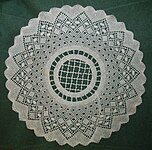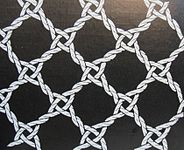Torchon lace



Torchon lace (Dutch: stropkant) is a bobbin lace that was made all over Europe.[1] It is continuous, with the pattern made at the same time as the ground. Typical basic stitches include whole stitch, half stitch, and twists, and common motifs include spiders and fans.[2] Torchon lace was notable historically for being coarse and strong, as well as consisting of simple geometric patterns and straight lines.[3] It did not use representational designs, for the most part.[4]
History[edit]
The exact origins of Torchon style laces are unclear. Evidence from portraiture does indicate that a Torchon-like lace trim, with typical 45 degree angled ground and motifs outlined with heavier gimp threads, may presage the development of the lace now known as Torchon, as well as other laces sometimes called "peasant lace".[5] Examples of the geometric style laces have been identified from the 17th century.[6] The word is derived from the French term for "dishcloth", and may suggest that the lace was a more durable and sturdy lace than some other fashionable laces.[5] It was in the 19th century that the term for this style of lace became attached to the characteristic angular forms and motifs we think of today.[6] Torchon lace was used by the middle classes for edging or insertion, and also to trim cotton and linen underwear, where it was ideal because of its strength and because it was inexpensive.[4] Torchon lace was originally made from flax, but cotton is used as well, and has been for a long time.Traditionally it was made in strips 1 to 2 inches (2.5 to 5 cm) wide.[4] Torchon lace generally has a gimp outlining the pattern. The gimp was first used in Sweden, but now is used generally.[4]
Colored threads were occasionally used historically, but in general Western European Torchon lace was typically white.[4] However, a number of laces that are sometimes termed "peasant lace" use similar motifs, and many of these can be found with very effective and vibrant color combinations especially in Eastern European traditions.
Torchon lace is one of the oldest laces, and is common to many lace-making regions such as Belgium, France, Italy, Saxony, Sweden and Spain.[7] Due to its simplicity, torchon lace is generally the first lace a lacemaker learns to make,[1] and has been since at least the 19th century. It only requires a few bobbins and uses thicker thread than other laces, which makes it easier to learn on. It is also the simplest of all the grounded laces.[3] Beggar's lace is an alternative term for torchon lace.[8][9]
Though it is one of the oldest laces, torchon lace was not made in England until the late 19th century, at which point it was made in the East Midlands, thus it is not considered an English lace. By the early 20th century, machine-made copies were being made that were almost indistinguishable from the hand-made lace.[4]
Modern[edit]
Modern Torchon lace making includes many kinds and colors of objects, no longer limited to the edging or insertion strips of the historical interest, although patterns are available to recreate many samples of these types.[10] Grids of 60 degrees can be employed with Torchon stitches to make round items.[11] New designs and motifs are available to lacemakers,[12] sometimes with extensive use of colors and beads.[13] Public art with Torchon lace objects can be viewed as part of the Headford Lace project in Ireland.[14] Torchon can even be used at much larger scale with recycled materials and larger cables to make public art installations, such as those seen in the work of Mary Elizabeth Barron.[15] Artists like Jane Atkinson have brought Torchon lace into the 21st century with new patterns and colors.[16] Using lace artwork to address issues such as climate change bring new views and perspectives to environmental issues.[17]
Gallery[edit]
-
Band (Italy), 17th–18th century (CH 18339099)
-
half stitch motives, spiders
-
cloth stitch motives, gimp
-
leaves
-
fans and basic ground
-
still pinned on the pillow
-
half stitch motives, spiders, an asymmetrical ground
References[edit]
- ^ a b "Torchon lace". Encyclopædia Britannica (online ed.). Retrieved 2008-05-23.
- ^ "LACE, A RICH TRADITION". Kant Centrum Brugge. Retrieved 2023-09-01.
- ^ a b Fuhrmann, Brigita (September 1985). Bobbin Lace: An Illustrated Guide to Traditional and Contemporary Techniques. Dover. p. 67. ISBN 0-486-24902-6. Retrieved 2008-05-23.
- ^ a b c d e f Earnshaw, Pat (February 1999). A Dictionary of Lace. Dover. p. 171. ISBN 0-486-40482-X. Retrieved 2008-05-23.
- ^ a b Levey, Santina M. (1990). Lace: a history ([Nachdr. der Ausg.] London 1983 ed.). London: Victoria & Albert Museum. ISBN 978-0-901286-15-4.
- ^ a b Toomer, Heather (2001). Antique lace: identifying types and techniques. Atglen (Pa.): Schiffer. ISBN 978-0-7643-1384-4.
- ^ Raffel, Marta Cotterell (January 2003). The Laces of Ipswich: The Art and Economics of an Early American Industry, 1750-1840. UPNE. p. 153. ISBN 1-58465-163-6. Retrieved 2008-05-22.
- ^ Prince, Darwin Porter & Danforth (2006). Frommer's® Puerto Rico (8th ed.). Hoboken: John Wiley & Sons. p. 157. ISBN 9780470068663.
- ^ Bath, Virginia Churchill (1979). Lace. Chicago: Regnery. p. 196. ISBN 9780140463781.
- ^ Lewis-Wild, Robin (1988). 101 Torchon Patterns. London: Dryad Press Ltd. ISBN 0713487194.
- ^ Dye, Gillian; Leader, Jean (2021). Lace Identification | A Practical Guide. UK: The Crowood Press. ISBN 9781785008665.
- ^ Sorenson, Veronica D. (1989). Design Techniques for Modern Lace. London: B. T. Batsford Limited. ISBN 0-7134-6021-0.
- ^ Tregidgo, Jan (2010). Torchon Lacemaking: A step-by-step guide. UK: The Crowood Press. ISBN 978-1847972019.
- ^ "Headford Lace Project". Headford Lace Project. Retrieved 2023-09-01.
- ^ Banatova, Daniela (2020-12-26). "'Recycled' Lace Art Mary Elizabeth Barron Australian lace maker". Bobbinlace.online. Retrieved 2023-09-01.
- ^ Atkinson, Jane. "Old Tradition: Modern Interpretation". Contemporary Lace. Retrieved 2023-09-02.
- ^ Fullman, Jane (2018-11-09). "EBB 'N' FLOW EXHIBITION AT WALFORD MILL CRAFTS". Bobbin & Wire. Retrieved 2023-09-02.
External links[edit]
Ireland, Design & Crafts Council (March 26, 2021). "European Artistic Craft Days: Headford Lace Project" (video). youtube.com. Design & Crafts Council Ireland.
Thompson, Karen. (July 18, 2016). "The Torchon Lace Company: The fine line between entrepreneurship and fraud".[1]
- ^ Thompson, Karen H. (2016-07-18). "The Torchon Lace Company: The fine line between entrepreneurship and fraud". O Say Can You See | National Museum of American History. Retrieved 2023-09-01.












